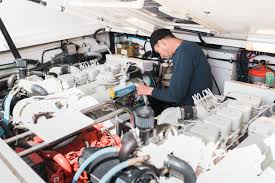Inboard Marine Engines: Service and Repairs
Inboard marine engines power many larger boats and yachts, including cruisers, fishing vessels, and commercial boats. These engines are mounted inside the hull and connected to the propeller via a drive shaft. They typically offer more power than outboards and require a different maintenance approach.
Proper maintenance is essential for ensuring performance, safety, and reliability. Neglecting routine service can lead to major repairs, safety issues, and unexpected breakdowns.
Importance of Regular Inboard Engine Maintenance
Regular service is vital for:
- Engine longevity
- Boating safety
- Fuel efficiency
- Avoiding major repairs
Key Maintenance Tasks for Inboard Marine Engines
- Oil and Filter Changes
Change oil and filters every 50–100 hours or at least once a year. Clean oil reduces friction and wear. - Coolant System Maintenance
Inboard engines use closed-loop cooling systems. Check coolant levels regularly. Inspect heat exchangers and raw water pumps for corrosion or blockages. - Fuel System Inspection
Replace fuel filters, check fuel lines for cracks or leaks, and clean injectors if needed. - Drive System Maintenance
Inspect drive shafts, bearings, and seals for wear or misalignment. In stern-drives, check bellows and gimbal bearings for damage or leaks. - Exhaust System Checks
Inspect manifolds, risers, and hoses for corrosion, leaks, or blockages. A failed exhaust system can cause carbon monoxide buildup or allow water into the engine. - Transmission and Gearbox Service
Change transmission fluid regularly. Inspect gearboxes for leaks or wear. Misalignment can reduce performance. - Belt and Hose Inspection
Check for worn or loose belts and cracked hoses, especially in the cooling and accessory systems. - Battery and Electrical System Maintenance
Test the battery and clean terminals. Inspect the alternator, starter motor, and wiring to prevent electrical issues.
Common Inboard Engine Repairs
- Overheating Repairs
Cause: Failed water pump, clogged heat exchanger, or low coolant.
Solution: Replace impeller, flush coolant system, repair leaks. - Transmission Issues
Cause: Low fluid, worn gears, misalignment.
Solution: Refill or replace transmission fluid, realign shaft, repair gearbox. - Starter Motor and Alternator Failures
Cause: Electrical component failure.
Solution: Replace faulty components or corroded wiring. - Fuel System Problems
Cause: Dirty filters, degraded lines, or clogged injectors.
Solution: Clean or replace affected components. - Exhaust Manifold and Riser Replacement
Cause: Corrosion from seawater exposure.
Solution: Replace damaged parts to prevent water intrusion and exhaust failure. - Ignition System Repairs
Cause: Worn spark plugs, coils, or distributor faults.
Solution: Replace ignition components as needed.
Frequency of Inboard Engine Service
- Annual Service: At least once a year, covering all major systems.
- Usage-Based Service: Every 100–200 hours, especially for commercial vessels.
- Seasonal Service: Before and after storage for seasonal boats.
DIY vs. Professional Inboard Engine Service
While owners can handle basic tasks like oil changes, complex jobs (electrical, fuel, exhaust, or transmission repairs) should be done by qualified marine mechanics with the proper tools and training.
Professional services typically include:
- Engine diagnostics
- Component repair or replacement
- System tuning for optimal performance
Popular Inboard Engine Brands in Australia
- Volvo Penta – Reliable and high-performance, used widely in powerboats and yachts
- MerCruiser – Produces inboard and sterndrive engines with strong support and parts availability
- Cummins – Offers powerful diesel engines for commercial and long-range cruising vessels
- Yanmar – Known for fuel-efficient diesel engines, especially in sailboats and commercial boats
Conclusion
Inboard engines are the core of many vessels and require consistent, professional care. With proper maintenance and timely repairs, boaters can ensure safe, efficient, and reliable performance. Investing in engine care now helps avoid costly issues later and keeps your boat ready for every voyage.
